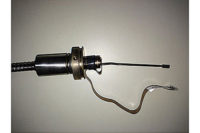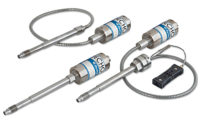Auto-Kabel, the global automotive supplier, manufactures cable and lead sets for power supply applications. The friction welding machines deployed in the process must always have an adequate supply of material without excessive safety stocks. To ensure the material doesn’t run out and lead to machine idle time, Auto-Kabel needed a system to provide total transparency of stock levels in first-in, first-out (FIFO) racks and to ensure reliable parts replenishment.
At Auto-Kabel’s eight manufacturing locations, line-side flow racks present parts and materials to workers and machines. Parts are delivered in storage bins. The flow-rack system is also deployed at the company’s headquarters operation in Hausen im Wiesental. The racks are located next to the manufacturing machines and provide operators with components such as cable shoes and eyelets. The flow racks contain more than 90 stock locations. Each location is filled with three bins, and each bin contains approximately 400 parts.
The industrial engineering department at Auto-Kabel is responsible for optimizing manufacturing processes on all sites. Staff immediately recognized that there was great potential to improve the kitting of parts for the welding machines, where there had always been bottlenecks.
The high throughput of components like cable shoes and eyelets often led to shortages and idle time because replenishment was inadequate. Auto-Kabel needed to eliminate idle time without excessive cost or an increase in the amount of safety stock.
Another issue was machine downtime. Operators often had to leave their machines to find assistance from logistics if they had run out of material, during which time the machine was not operating. Stoppages were frequent and lengthy. A quick solution was urgently required.
The StockSAVER kanban system from WERMA solved the problem.
“We already knew about WERMA from its machine monitoring and data collection system SmartMONITOR, which we really like, so we had a look around to see what else WERMA could offer and found StockSAVER,” comments Maik Engelhardt, pilot project leader for industrial engineering at Auto-Kabel.
Following an initial presentation and site visit, Auto-Kabel decided to equip three flow racks containing 90 stock locations with the system. From the beginning of the trial, it was clear that the system proved to be of real benefit, so further material replenishment locations would also be equipped with the kit.
“The system seemed to offer a lot, and we were sure that we could optimize material replenishment with StockSAVER and minimize the idle time on the friction welding machines,” says Engelhardt.
StockSAVER is a maintenance-free system that is easy to retrofit to any FIFO flow rack. Sensors fitted to the flow racks ensure complete transparency of stock levels and safeguard against material running out or misplaced stock.
The system works simply—sensors monitor the number of bins held on the FIFO flow racks. The number and movement of bins is sent to the SmartBOX, which wirelessly sends the information to the StockSAVER software. The software compiles the data and displays the actual stock held on the flow racks.
The system solves many traditional kanban problems, such as lost or damaged kanban cards or human error in replacing bins on the racks. It also frees up space on the factory floor for other activities, and it improves cash-flow. The automatic stock replenishment system reduces the margin for human-error and can considerably reduce the levels of safety stock held.
“One of the big advantages of StockSAVER is that the sensors can be fitted to virtually any flow rack system,” explains Manual Schutzbach, technical sales engineer at WERMA. “The removal of a bin from a rack will automatically signal to logistics the new stock level status, thus ensuring priority-driven replenishment.”
In addition, manual errors such as forgotten, mislaid or damaged kanban cards become a thing of the past. There is no need to scan removal of bins from a location and thus, the danger of “double bookings” or arithmetically incorrect stock levels can be avoided.
“StockSAVER can also permit a substantial reduction in the number of flow racks required line-side delivery because the amount of stock required can be lowered. This improves cash-flow, and floor space can be made free for other value-adding activities,” continues Schutzbach.
Data is transmitted wirelessly to the StockSAVER software delivered with the system and then shown in various display views. Auto-Kabel was extremely impressed with the displays.
“Installing and setting up both the hard-ware and software was really intuitive, and there wasn’t the need for a large team to oversee the task,” says Alicia Schwald, joint project leader for industrial engineering at Auto-Kabel. “The software displays the stock levels of all flow racks connected to the network on PC displays and gives complete transparency of all available material.”
The control station view gives a complete overview of the exact stock levels at the workstation. A requirements list shows the priority list for replenishment and creates a to-do list for logistics to work with. In this way, errors are avoided, the replenishment process is optimized, and the levels of safety stock are reduced.
The software can provide analysis of usage so that processes can be improved. The user can also export the data on material movement.
“We have now installed StockSAVER in production control, logistics and manufacturing, and we make most use of the control station and requirements lists,” notes Engelhardt.
“Straight after setting the system up, we were able to reduce idle time and safety stocks. The project paid for itself within six weeks,” explains Schwald.
Furthermore, operators no longer have to leave their workstations to seek help, as StockSAVER automatically reports a requirement for stock replenishment. The control station displays the flow racks at Auto-Kabel, including the part number and stock location, the priority for replenishment, and the correct number of bins per part number. By exporting the data further, analysis can be carried out to optimize the process.
“After we completed the first trial, we wanted to introduce a ‘place by light’ system on the flow racks to achieve an even higher degree of safety and avoid any danger of misplacement of bins,” says Engelhardt. “This should make it even more obvious to the logistics operator precisely where to replace the replenishment bin.”
With the provision of additional “place by light” LEDs, the logistics operator is able to see a green LED at the head of the correct stock location after scanning the bar code on the bin to be replenished. If the bin is replaced into the wrong location, a red LED is lit.
“Now all of our demands have been met and mix-ups in replenishing stock locations have been eliminated,” concludes Engelmann.
At Auto-Kabel, flow racks with stops are used so that a bin can be removed and replaced in its original position without the next bin sliding down and signaling a stock movement through StockSAVER. This is an important feature for the process at Auto-Kabel and means that the call for replenishment will only be activated when the next bin has been pulled through the “stop.”
“All staff, from team leaders to operators, have been won over by the simple functionality of the system and are really happy that replenishment is now carried out automatically and error-free,” says Engelhardt. “We will be presenting StockSAVER at our next ‘lean workshop’ for our other locations. During the workshops, we often present ideas from different locations and we will definitely be recommending StockSAVER to our other subsidiaries.”
Currently, the StockSAVER system is not available in North America. WERMA plans to make it available in 2019.
For more information on signal lights, machine monitoring and kanban systems, call WERMA at 315-414-0200 or visit www.werma.com.





